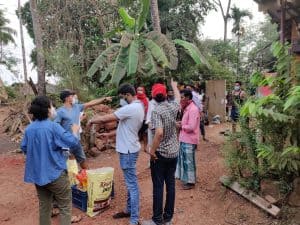Act for Goa gets Felicitated
Posted on 08/12/2022Many of you have probably heard of or seen posters for the Goa Humanitarian Helpline since the lockdown in Goa started. This amazing group of people and organizations saw a need of the hour and stepped up to the plate to come together and put systems into place to offer support in whatever way they could. We spoke to Govind Mukandan from Sensible Earth to find out more about how this group came together and what these incredible volunteers have been able to accomplish in the last few weeks.
How Did the Goa Humanitarian Helpline get started?
On March 24, a total lockdown of Goa was announced. On March 25, the Goa Humanitarian Helpline (GHH) was born—in the form of a helpline associated with the Corporation of City of Panaji’s grocery delivery service. Residents of Panaji would call in their grocery orders, and we would log them (and in some cases help with packing and dispatch).
Soon it became clear that a humanitarian crisis was brewing, especially for migrant workers, the elderly and other vulnerable groups. And that is when we expanded focus from Panjim to Goa; from groceries to food, medicine and hygiene products; and from paying customers to people in distress.
How did you recruit and manage volunteers across the state to help man the line?
The volunteer response to the helpline has been stunning. We were looking for a way to respond to the crisis—and so it turned out were many others. GHH is really a citizens’ initiative so many, many organizations and individuals are involved.
The initial call for volunteers went out through personal networks and the Sensible.Earth community, but very quickly others like Offbeat Goa came on board who had the social media power to really step up our numbers. All told, the GHH umbrella comprises about 67 people—plus perhaps another 100 on-ground ‘champions’ in the broader partner network, including the good folks from Soul Travelling, Panjim Inn, TEDX Panaji and other organizations.
How did you manage to coordinate so many people given the restrictions of the quarantine and social distancing? What were the biggest challenges you faced in doing all of this?
In a word: technology! We used a cloud telephony platform to take calls; volunteers coordinated via WhatsApp, phone and Zoom video; and GHH tools and processes were run via Google Sheets (and later on also Google Forms). It helped to have some bright technical sparks including a freelance developer, and Tech4Wildlife who helped with digital cartography.
How many groceries were you able to deliver in those early days?
In the early days, roughly 7,200 people in and around Panjim. And then of course we managed to assist several thousands more Goa-wide, but this time it was migrant workers who had less than a day’s worth of food, the elderly, in some cases people with disability etcetera.
How many calls did you volunteers take over the lifespan of the helpline? How many migrant communities were you able to identify and help feed?
GHH has taken 20,000 phone calls—and counting! 5,500+ migrant workers have been provided with 3-7 days’ worth of provisions. We also used the Sensible.Earth premises to establish a food bank with over 5 tons of rations and sanitary products; obtained permits for 5 delivery vans to distribute food; and established working partnerships with gurudwaras, charitable organizations and panchayats.
What is next for the helpline and for the future of this network of volunteers?
We are working on a few potential ways forward, such as evolving into a formal organization; or even becoming a volunteer-based “sleeper cell” disaster relief helpline that springs to life when the next crisis hits. Choosing a path that has the support of our volunteer community is absolutely crucial so that’s what we’re doing right now.
What are some of the learnings from this whole process, or advice that you would like to share with other volunteer groups trying to help support vulnerable communities during this lockdown?
Our experience has been that forging something of social value and getting it from 0 to 100 kilometres per hour in a matter of hours or days is actually the easy part. The hard part is people, i.e. how to keep a large group of people informed, engaged, aligned and rowing in the same direction without all the infra of a formal enterprise.
What was the most inspiring thing you saw come out of all of this?
The way in which complementary pieces just fell into place and the amazing collaborative spirit of everyone involved. Organizations like Journeys with Meaning, Sahasea, Make It Happen, Blurb, Goa Outreach, Red Cross and Terra Conscious plus an army of individual contributors have been inspiring teammates. And there are many others!
If there is one thing you would like to see continue from all of this what would it be?
All of us would love to see the volunteering spurred by this crisis become a larger movement of civic engagement. Few of us can afford to work on social or ecological impact projects indefinitely without compensation, but we can all do more for our fellow human beings and/or planet.











